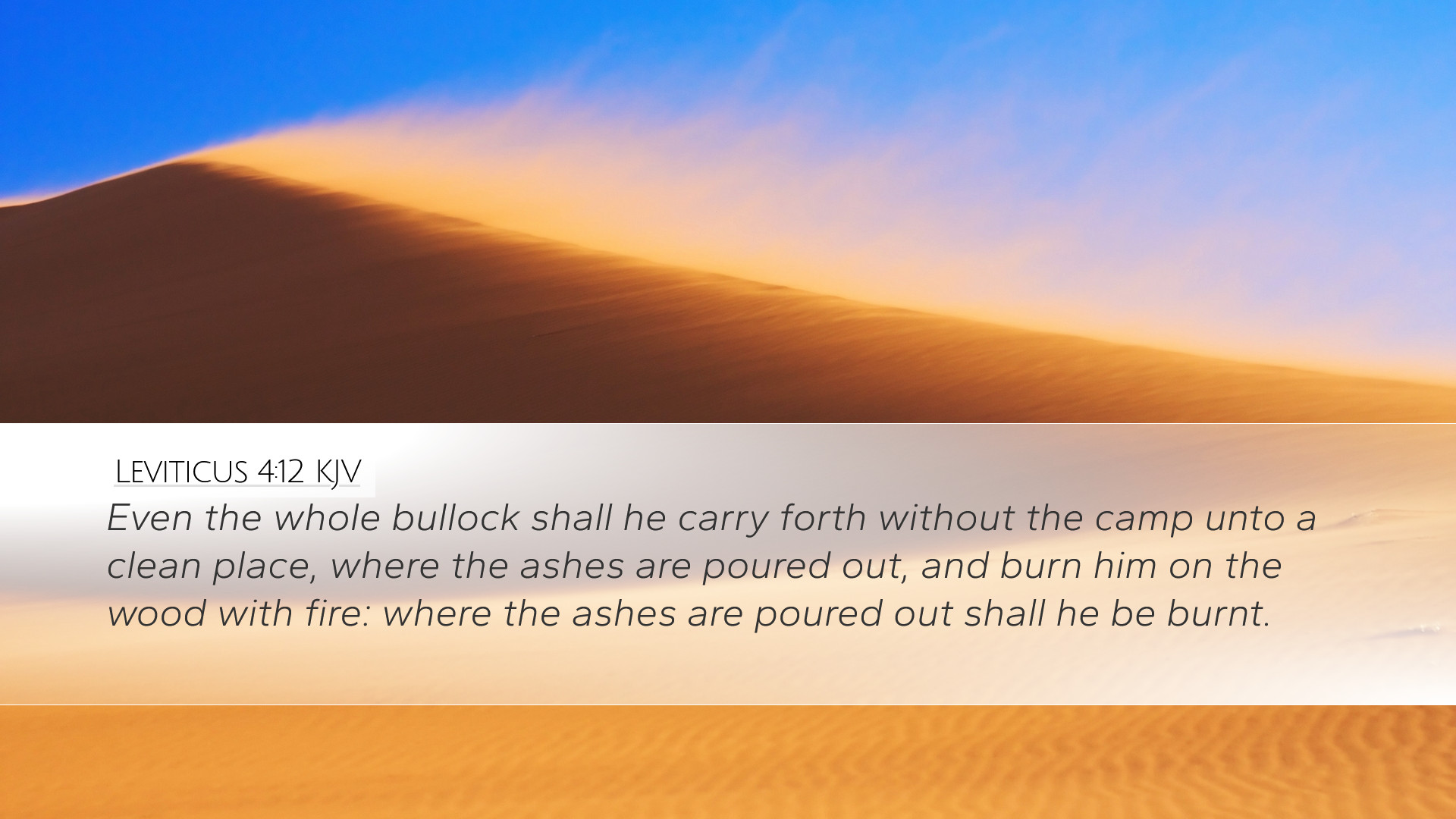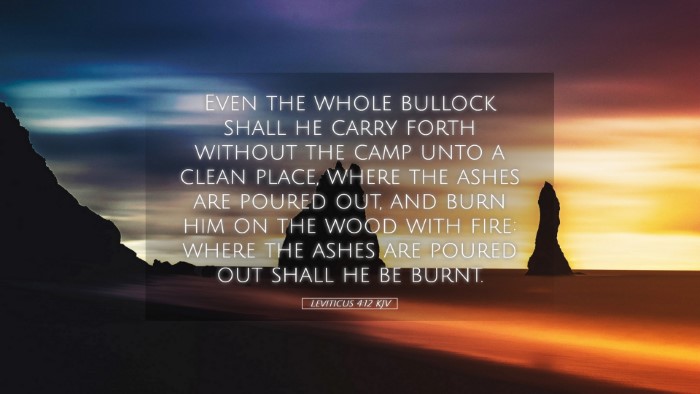Commentary on Leviticus 4:12
Verse Text: "And the whole bull shall be brought out of the camp to a clean place, where the ashes are poured out, and it shall be burned on wood with fire; where the ashes are poured out, it shall be burned."
Introduction
The book of Leviticus outlines the laws and regulations governing the Israelites, particularly concerning the sacrificial system. Leviticus 4 focuses on sin offerings, emphasizing atonement for unintentional sins. This verse, Leviticus 4:12, specifically details the prescribed method of handling the bull used for sin offerings, which carries rich theological and practical implications for understanding sin, atonement, and the holiness required by God.
The Significance of the Offerer
This verse speaks to the individual bringing the offering. The bull represents a significant sacrifice, indicating the seriousness of the sin committed. The requirement to bring the whole bull emphasizes the totality of the offering made to God. According to Matthew Henry's Commentary, "Nothing less than the whole is offered to signify the completeness of the atonement required." This serves as a powerful reminder of the weight of sin and the high cost of redemption.
The Location: Outside the Camp
In Leviticus 4:12, the specific instruction for the bull to be carried outside the camp is pivotal. This act symbolizes several important truths:
- Cleansing and Purity: Albert Barnes notes that the act signifies the removal of sin from the community, illustrating God's holiness and the necessity of purity among His people.
- Foreshadowing Christ: The act of taking the bull outside signifies a prefiguration of Christ, who suffered outside the city gate (Hebrews 13:12). As Adam Clarke observes, "This external location of the sacrifice is a powerful symbol of Christ bearing our sins far from us."
The Method of Sacrifice: Burning the Bull
Leviticus 4:12 concludes with the directive that the bull be burned where the ashes are poured out. This method of sacrificial consumption carries profound implications:
- Complete Consumption: The total burning of the offering symbolizes the complete judgment on sin. In Matthew Henry's view, the sacrifice being wholly consumed reflects the intensity of God's wrath against sin and the need for total atonement.
- Holistic Atonement: Albert Barnes explains that this practice illustrates the need for total commitment in the act of atonement, emphasizing that half-measures are inadequate before God.
Theological Implications
The rich symbolism in Leviticus 4:12 encompasses various theological insights crucial for understanding God's character and His dealings with humanity:
- God's Holiness: The positioning of the offering outside the camp highlights God's holiness and the separation of sin from His presence. The act of burning the sacrifice reinforces the gravity of sin and its consequences, as explored by Adam Clarke who comments on the necessity of recognizing the seriousness of transgressions.
- Atonement and Forgiveness: This verse exemplifies the process of atonement where sin is acknowledged, the sacrificial offering made, and the hope for forgiveness is established. Matthew Henry emphasizes that true repentance must accompany the act of atonement for it to be meaningful.
- Christ's Sacrifice: The imagery of the sacrifice being taken outside and completely burnt foreshadows the ultimate sacrifice of Jesus Christ, akin to the acknowledgment by Albert Barnes linking the bull with Christ, the Lamb of God offered for the sins of humanity.
Practical Applications for Today
The insights drawn from Leviticus 4:12 invite reflection and practical application for contemporary believers:
- Recognition of Sin: Understanding the seriousness of sin encourages believers to approach God with humility and earnestness. As observed by Adam Clarke, acknowledging our shortcomings leads us closer to true repentance.
- Commitment to Purity: The necessity of involving the community in the process signifies the collective responsibility of maintaining purity and holiness, as highlighted by Albert Barnes. Church leaders and members must foster environments of accountability and care.
- Embracing Christ's Atonement: The imagery used in this passage leads believers to a deeper appreciation of Christ's sacrifice, urging them to live in gratitude and holiness that reflects the love of God.
Conclusion
Leviticus 4:12 serves as a solemn reminder of the cost of sin and the profound grace available through the sacrificial system established by God. When viewed through the lens of Christ's ultimate sacrifice, the passage offers hope and encourages believers to engage earnestly with their faith, pursuing holiness and an intimate relationship with God. Engaging with this verse allows us to appreciate the depth of God's plan for redemption that flows throughout Scripture.


